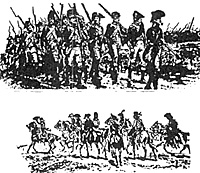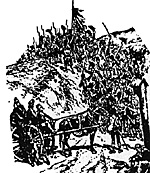
The Battle of Maida was fought by a British force under General Stuart and a French force under General Reynier.
British - 7 battalions divided into:
Advance Corps under Kempt
1st Bde under Cole
27th Foot
Grenadier Coys of Bus
1 Horse & 1 Field gun
2 Bde under Acland
78th Foot
81st Foot
1 Field gun
3rd Bde under Oswald
58th Foot
Watteville's Regt
1 Field gun
Ross
20th Foot
French
Compere's
Bde
2 Bns 1st Light Infantry
2 Bns 42nd Line Infantry
Peyri's
Bde
1 Bn Swill Infantry
2 Bus Polish Infantry
Digonet's
Bde
2 Bus 23rd Light Infantry
1 Squadron Horse Chasseurs
2 Horse guns
These formations, on both sides, vary in quality. That is, some of them are veterans and others are inexperienced troops. See below for these grades and for their implication on the rules.
The French will enter in column and then go into 3 deep formations. The British enter in column and then go into 2 deep formations.
The Battle
 The battle begins with the French cavalry and horse artillery creating a disturbance in
the French front-center (1st move). At the beginning, with the above, Kempt's Light Infantry
come on the field at the British right with the right flank on thickets skirting the River Lamato.
The battle begins with the French cavalry and horse artillery creating a disturbance in
the French front-center (1st move). At the beginning, with the above, Kempt's Light Infantry
come on the field at the British right with the right flank on thickets skirting the River Lamato.
4th move. Compere's Bde comes on the French left, facing Kempt. Acland's Bde comes on at Kempt's left.
6th move. Peyri's Bde come on at Compere's right. Cole's Bde comes on at the British extreme left. Oswald's Bde remains just off the table in reserve at the British center.
9th move. Digonet's Bde come on at the French extreme right.
10th move. Ross arrives on Cole's left with the 20th Foot.
Unit experience:
French Veterans
1st Light Infantry
42nd Line Infantry
French Average
23rd Light Infantry
Horse Chasseurs
Artillery
French Poor
Swiss Infantry
Polish Infantry
British Elite
Kemp's Light Infantry
The Grenadier coys of Bde
British Veteran
27th Foot
20th Foot
Watteville's Regt.
Artillery
British Average
78th Foot
81st Foot
58th Foot
Elite units add 2 to each die. Add one third to move distance (representing the unit's
rapid assessment of the situation and general sharpness of reaction)
Veteran units add 1 to each die.
Average units carry on as usual.
Poor units use 'red' percent chart. If they are routes, deduct I from die scores while continuing to use the 'red' chart. Lose one third on all move distances.
Smoke
Once firing begins, the deviation stick will be used in that third of the table when a unit moves or fires. Deviation direction is indicated by a 1-6 die roll. When firing has occurred all along the line the deviation device will be used for everyone. When there has been no firing for 3 moves, the deviation device is no longer used in that third of the table.
Surprise
Units moving and arriving at an unexpected location can cause surprise. On first being contacted: recruits throw first, adding 2 5% to the required score; average units add 10%; Veteran units are OK. If contact is to the flank or rear: recruits add 50% to the score; average add 33%; veterans add 25%. For infantry NOT in square when hit unexpectedly by cavalry: recruits immediately rout; average are shaken and withdraw 1 move, then need 50 or more to avoid rout; veterans stand but need 50 to avoid withdrawal, under 30 is a rout.
Back to MWAN #95 Table of Contents
Back to MWAN List of Issues
Back to MagWeb Magazine List
© Copyright 1998 Hal Thinglum
This article appears in MagWeb (Magazine Web) on the Internet World Wide Web.
Other military history articles and gaming articles are available at http://www.magweb.com